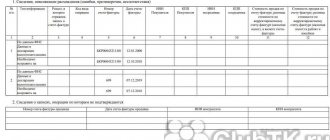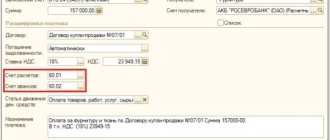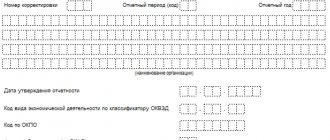When are Forms 3, 4 and 6 of the balance sheet prepared?
Forms 3, 4 and 6 of the balance sheet are included in the annual financial statements and are appendices to its main forms (balance sheet and income statement):
- Form 3 - statement of changes in capital;
- Form 4 - cash flow statement;
- Form 6 - report on the intended use of funds.
The application forms, as well as the main forms of accounting, are approved by Order of the Ministry of Finance of Russia “On Forms of Accounting Reports of Organizations” dated July 2, 2010 No. 66n. The same document contains a rule establishing that in a simplified version of reporting, the required forms are a balance sheet, a report on financial results and a report on the intended use of funds, and explanations for them should be drawn up only if absolutely necessary (clause 6).
IMPORTANT! When preparing reports for 2021, keep in mind that accounting forms have changed. Key differences: reporting can only be prepared in thousands of rubles; millions can no longer be used as a unit of measurement. OKVED has been replaced by OKVED 2. For other changes, see here.
Read more about existing balance sheet options in the article “Balance Sheet (Assets and Liabilities, Sections, Types).”
Since the report on the intended use of funds (Form 6) is intended for use when there is a movement of funds for a very specific purpose, it is not always used. Thus, Forms 3, 4 and 6 may not be prepared by persons reporting under the simplified form.
For information about who can use simplified reporting, read the material “Simplified reporting for small businesses” .
But the set of reports generated according to its full version will include forms 3 and 4. In this case, Form 6 and other explanations will be issued if necessary.
ConsultantPlus experts provided step-by-step instructions for filling out appendices to financial statements. Get trial access to the K+ system and proceed to the financial statements manual for 2020.
Read about the principles that serve as the basis for the formation of accounting records in the article “What requirements should accounting records satisfy?” .
Accounts receivable and payable
In this section, disclose information on the following lines of the Balance Sheet:
- line 1230 “Accounts receivable”;
- line 1410 “Borrowed funds”;
- line 1450 “Other obligations”;
- line 1510 “Borrowed funds”;
- line 1520 “Accounts payable.”
The section consists of two tables for information on accounts receivable and two for accounts payable.
In table 5.1 “Availability and movement of accounts receivable” for long-term and short-term accounts receivable by their types, indicate information on the availability of accounts receivable at the beginning and end of the period, its changes during the period (receipt, disposal), as well as information on the reserve for doubtful debts
In the column “At the beginning of the year”, reflect in aggregate the debit balance of accounts 60, 62, 66, 67, 68, 69, 70, 71, 73, 75, 76 as of January 1 of the reporting year.
In the “At the end of the period” column, indicate the balance of accounts receivable as of the end of the reporting year.
In the “Changes during the period” column, reflect the receipt and disposal of debts, as well as the transfer of debt from long-term to short-term.
Indicate the amounts of receivables in full according to the terms of the contracts (i.e., without taking into account the reserve for doubtful debts created for it) (clause 35 of PBU 4/99).
In Table 5.2, Overdue Receivables, disclose information on overdue receivables (that is, debts that have expired) as of the reporting date and as of December 31 of the previous two years. Indicate the amounts of debt by type in two estimates: according to the terms of the contracts (i.e., in full) and in the balance sheet estimate (i.e., minus the reserve for doubtful debts created for it).
An example of how to prepare explanations for the Balance Sheet and the Statement of Financial Results regarding accounts receivable
Before preparing the annual financial statements, the accountant of Alpha LLC carried out an inventory of accounts receivable.
Data for 2015
On the debit of account 62:
- 400,000 rub. – debt for goods shipped to Delta on December 27, 2014 under supply contract No. 125 dated December 20, 2014 (payment due until February 1, 2021) – current, short-term debt;
- 50,000 rub. – debt for goods shipped to Gamma on May 21, 2015 under supply contract dated May 16, 2015 No. 86 (payment due until June 1, 2015); – debt is overdue, short-term, doubtful (not secured by guarantees), a reserve was created for doubtful debts;
- 50,000 rub. – debt for goods shipped to Omega on April 5, 2015 under supply contract dated March 31, 2015 No. 67 (payment due until June 1, 2015); – debt is overdue, short-term, doubtful (not secured by guarantees), a reserve was created for doubtful debts;
- 100,000 rub. – debt for goods shipped to Beta on October 10, 2015 under supply contract No. 95 dated October 1, 2015 (payment period until December 31, 2015) – the debt is overdue, short-term, a reserve for doubtful debts was not created.
On the credit of account 62:
- 50,000 rub. – the debt for goods shipped to Gamma on May 21, 2012 under the supply agreement dated May 16, 2015 No. 86 was repaid;
- On June 29, 2015, Gamma paid the debt in full. The provision for doubtful debts was restored in the amount of RUB 50,000;
- 50,000 rubles – the debt for goods shipped to Omega on April 5, 2015 under the supply agreement dated March 31, 2015 No. 67 was written off from the reserve for doubtful debts.
“Alpha” carried out claims work and tried to collect the debt from “Omega” in court. It was not possible to collect the debt. On November 6, 2015, Omega was declared bankrupt by a court decision. As a result, this receivable was recognized as uncollectible and was written off in December 2015 against the provision for doubtful debts;
- 100,000 rub. – the debt for goods shipped to Beta on October 10, 2015 under the supply agreement dated October 1, 2015 No. 95 was repaid;
- On February 1, 2015, Beta paid the debt in full.
On the debit of account 76:
- 1,000,000 rub. – debt under the interest-free loan agreement dated July 19, 2015 No. 1 with A.S. Kondratyev (loan issued on July 19, 2015 for a period until July 18, 2021, repaid in a lump sum in full upon expiration of the contract) – current, long-term debt.
On the debit of account 60:
- RUB 1,500,000 – an advance payment was transferred under the supply agreement No. 55 dated December 22, 2015 with Hermes (delivery period of goods until January 20, 2021) – the debt is current, short-term.
There are no other types of receivables.
On the debit of account 63:
- 50,000 rub. – the reserve for Gamma’s debt under the supply agreement dated May 16, 2015 No. 86 was restored;
- 50,000 rub. – Omega’s debt under the supply agreement dated March 31, 2015 No. 67 was written off from the reserve.
Total as of December 31, 2015:
- accounts receivable accounted for under contracts – RUB 2,900,000, including:
- 400,000 rub. – customer debt (short-term);
- RUB 1,500,000 – debt of suppliers (short-term);
- 1,000,000 rub. – debt on interest-free loans issued (long-term);
- amount of reserve for doubtful debts – 0 rub.;
- balance sheet data on line 1230 “Accounts receivable” – RUB 2,900,000. (RUB 400,000 + RUB 1,500,000 + RUB 1,000,000).
Data for 2014
On the debit of account 62:
- 50,000 rub. – debt for goods shipped to Gamma on May 21, 2014 under supply contract dated May 16, 2014 No. 86 (payment due until June 1, 2014); – debt is overdue, short-term, doubtful (not secured by guarantees), a reserve was created for doubtful debts;
- 50,000 rub. – debt for goods shipped to Omega on April 5, 2014 under supply contract dated March 31, 2014 No. 67 (payment due until June 1, 2014); – debt is overdue, short-term, doubtful (not secured by guarantees), a reserve was created for doubtful debts;
- 100,000 rub. – debt for goods shipped to Beta on October 10, 2014 under supply contract No. 95 dated October 1, 2014 (payment period until December 31, 2014) – the debt is overdue, short-term, a reserve for doubtful debts was not created.
There were no other types of receivables.
On the credit of account 63:
- 50,000 rub. – a reserve for doubtful debts was created in relation to Gamma’s debt under the supply agreement dated May 16, 2014 No. 86.
Total as of December 31, 2014:
- accounts receivable accounted for under contracts – RUB 200,000. (customer debt, short-term), including overdue – RUB 200,000. (book value – 100,000 rubles);
- amount of reserve for doubtful debts – 100,000 rubles;
- balance sheet data on line 1230 “Accounts receivable” – 100,000 rubles. (200,000 rub. – 100,000 rub.).
Data for 2013
On the debit of account 62:
- 50,000 rub. – debt for goods shipped to Gamma on May 21, 2013 under supply contract No. 86 dated May 16, 2013 (payment due until June 1, 2013) – the debt is overdue, short-term, a reserve for doubtful debts was not created;
- 50,000 rub. – debt for goods shipped to Omega on April 5, 2013 under supply contract dated March 31, 2013 No. 67 (payment due until June 1, 2013); – debt is overdue, short-term, doubtful (not secured by guarantees), a reserve has been created for doubtful debts.
According to the terms of the agreements with Omega and Gamma, interest is not provided for late payments.
There were no other types of receivables.
On the credit of account 63:
- 50,000 rub. – a reserve for doubtful debts was created in relation to Omega’s debt under the supply agreement dated March 31, 2013 No. 67.
Total as of December 31, 2013:
- accounts receivable accounted for under contracts - 100,000 rubles. (customer debt, short-term), including overdue – RUB 100,000. (book value – 50,000 rubles);
- the amount of reserve for doubtful debts is 50,000 rubles;
- balance sheet data on line 1230 “Accounts receivable” – 50,000 rubles. (100,000 rub. – 50,000 rub.).
Based on these indicators, the accountant deciphered the data in the section “Accounts receivable and payable” of the Explanations to the Balance Sheet and the Statement of Financial Results.
Fill out Table 5.3 “Availability and movement of accounts payable” separately for long-term and short-term accounts payable by their types. Disclose information on debt balances at the beginning and at the end of the period, changes during the period (receipt, disposal) with the distribution of amounts of accounts payable arising within the framework of business activities and from accrued interest and fines (paragraph 10, paragraph 27 of PBU 4/99, p 2 and 17 PBU 15/2008).
In the column “At the beginning of the year”, reflect in aggregate the credit balance of accounts 60, 62, 66, 67, 68, 69, 70, 71, 73, 75, 76 as of January 1 of the reporting year.
In the “At the end of the period” column, indicate the balance of accounts payable as of the end of the reporting year.
In the “Changes during the period” column, reflect the receipt and disposal of debts, as well as the transfer of debt from long-term to short-term.
In table 5.4 “Overdue accounts payable,” disclose information on the balances at the end of the reporting period and as of December 31 of the previous two years of overdue accounts payable (i.e., debt that has expired) by type.
Form 3 balance sheet
Form 3 of the balance sheet is the statement of changes in equity. It contains information about the equity capital of the organization, which includes (clause 66 of the PBU on accounting and accounting, approved by order of the Ministry of Finance of the Russian Federation dated July 29, 1998 No. 34n):
- authorized (share) capital;
- Extra capital;
- Reserve capital;
- retained earnings;
- other reserves.
In addition, the report reflects information on own shares purchased from shareholders.
Form 3 consists of three sections:
1. Capital movement
This is a table that shows the change in the organization’s capital over 2 years (reporting and previous). It shows how the capital has changed (whether it has increased or decreased) and why the changes have occurred.
It's easy to fill out this section. First you need to indicate the balances as of December 31 of the year preceding the previous one. Then fill in the indicators for the previous year and display the capital balance as of December 31 of the previous year. Next, you need to reflect the movement and balance of capital at the end of the reporting year. Indicators are reflected in the corresponding columns and rows. For example, if there was an increase in additional capital due to a revaluation of property, the amount of the revaluation is reflected in the line “Revaluation of property” (column “Additional capital”).
2. Adjustments due to changes in accounting policies and correction of errors
The title of the section speaks for itself: it contains information about adjustments to the amount of capital caused by changes in accounting policies or associated with the correction of significant errors of previous years identified after the approval of last year’s financial statements. It is advisable to fill it out before section 1, since its data is used to determine the indicators of the first section.
3. Net assets
This contains information about the organization’s net assets for 3 years (the reporting year and the previous 2). The procedure for their calculation is determined by order of the Ministry of Finance of Russia dated August 28, 2014 No. 84n.
Read more about this procedure in the material “A new procedure for calculating net assets has been approved .
Form 3 can be found on our website using the link below:
Form 4 balance sheet
A Form 4 balance sheet is the common name for the cash flow statement. It contains information about the organization's cash flows for the reporting and previous years. Cash flows are detailed in the context of current, investment and financial transactions. For each type of activity, the receipt and expenditure of funds are shown.
At the same time, current operations include operations related to the implementation of ordinary activities. For example, receipts include sales proceeds and rental payments, while payments include payments to suppliers and wages. Investment transactions are those related to the acquisition, creation or disposal of non-current assets.
As cash flows from financial transactions, flows from operations related to attracting financing on a debt or equity basis, leading to a change in the size and structure of the capital and borrowed funds of the organization (credits, borrowings, deposits, etc.) are classified.
The procedure for filling out the report is described in detail in PBU 23/2011 “Cash Flow Report” (approved by Order of the Ministry of Finance of the Russian Federation dated 02.02.2011 No. 11n).
You can also download the form on our website using the link below:
A sample of filling out a cash flow statement was prepared by ConsultantPlus experts. Get trial access to the K+ system and download the document for free:
Form 6 balance sheet
The sixth form of balance sheet is a report on the intended use of funds, which is compiled by non-profit organizations (NPOs) and legal entities receiving any targeted funding.
For NPOs, this report is essentially the main one. In this report they disclose information about the intended use of funds received to support statutory activities. It shows the balance of targeted financing at the beginning of the reporting year, the receipt and expenditure of such funds during the reporting period and their balance at the end of the year.
Form 6, as well as the main reporting forms (balance sheet and financial results report), has 2 design options: full (Appendix 1 to Order No. 66n) and simplified (Appendix 5 to Order No. 66n). The latter may be made up of organizations that have the right to use simplified methods of accounting when preparing reports in a simplified form.
You can download both versions of Form 6 on our website using the links below:
Production costs
The “Production Costs” section is presented in one table, which discloses information on the following lines of the Income Statement:
- line 2120 “Cost of sales”;
- line 2210 “Business expenses”;
- line 2220 “Administrative expenses”.
In the table “Production costs”, disclose information about the composition of costs in the context of their elements (paragraph 12, paragraph 27 of PBU 4/99, paragraph 2, paragraph 22 and paragraph 8 of PBU 10/99). Indicate the cost amounts for two periods: the reporting period and the previous period.
Results
Forms 3, 4 and 6 are appendices to 2 main accounting reporting documents: the balance sheet and the financial results report. Forms 3 (statement of changes in capital) and 4 (statement of cash flows) are mandatory if the main reports are created in their full form. Form 6 (report on the targeted use of funds) is drawn up only if the reporting entity has funds for targeted financing. Just like the 2 main reporting forms, Form 6 can be prepared in a simplified version by an organization that has the right to maintain simplified accounting. For 2021, you must use the new edition of all specified forms.
Sources:
- Order of the Ministry of Finance of Russia dated July 2, 2010 No. 66n
- Federal Law of December 6, 2011 N 402-FZ “On Accounting”
You can find more complete information on the topic in ConsultantPlus. Free trial access to the system for 2 days.
Document form
Explanations can be made in text and (or) tabular form. They are usually presented in table form. You can decide what to include in such a table yourself, taking into account Appendix 3 to Order No. 66n of the Ministry of Finance of Russia dated July 2, 2010 (clause 4 of Order No. 66n of the Ministry of Finance of Russia dated July 2, 2010).
If you are filling out such Explanations for the statistics department or tax office, then after the column “Name of the indicator”, additionally enter the column “Code” into the tables. Enter line codes in accordance with Appendix 4 to Order No. 66n of the Ministry of Finance of Russia dated July 2, 2010. This procedure follows from paragraph 5 of Order No. 66n of the Ministry of Finance of Russia dated July 2, 2010.







